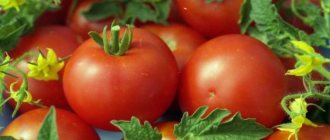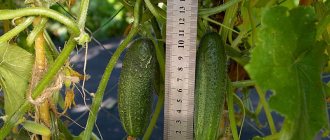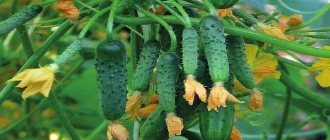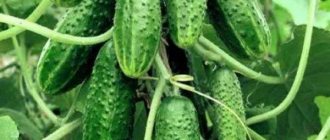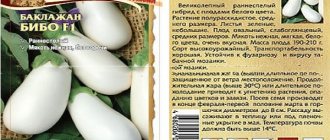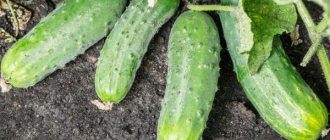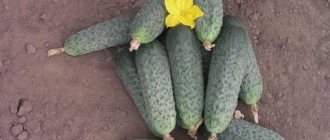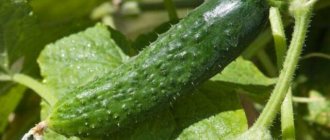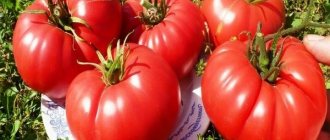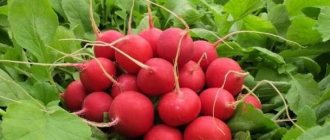Diseases and pests
Plants are highly resistant to the following diseases:
- Cladosporiosis;
- Cucumber mosaic;
- Powdery mildew.
Despite the innate resistance to various diseases, if improperly cared for, plants may develop symptoms of fusarium. In order to avoid this, you must follow all growing recommendations and carry out preventive treatment of the bushes with special insecticidal preparations. You can also periodically inspect the plants for lesions.
Among the pests that can cause harm to vegetable crops, aphids should be noted. These small insects can settle on bushes in whole colonies. You can get rid of “uninvited guests” by spraying the bushes with preparations that can be purchased at the store or prepared according to folk recipes.
Both an experienced gardener and a beginner can grow cucumbers of the Ginga variety. Caring for a plant is not difficult and does not require any special skills. If you follow the rules for growing, you can get a high yield.
cucumber Vyuga F1 - description and characteristics of the variety
Harvest and storage
When the fruits begin to ripen, they are harvested every 3-4 days. During mass fruiting, the crop is harvested daily, without leaving it on the bush for long. The use of cucumbers is universal. The fruits are suitable for pickling, pickling and fermenting. If you plan to eat it fresh, the harvest should be stored in the vegetable section of the refrigerator for no more than 7 days.
Find out how to make cucumbers without sterilization in your own juice.
High yield, excellent taste and disease resistance justify the high rating of the Mirabella F1 hybrid. With proper cultivation, timely watering, fertilizing, bush formation and pest prevention, the gardener is guaranteed to get excellent results.
Advantages and disadvantages
The main advantages of this hybrid include:
- Productivity at record level;
- Moderate parthenogenesis;
- High quality fruits;
- Strong immunity;
- High growth rates.
The disadvantages of the Ginga cucumber include:
- Lack of productive seedlings in the second generation;
- The need to annually update the seed fund;
- High cost of seeds.
Diseases and pests
If agrotechnical rules are not followed, Anzor cucumbers may be exposed to pests, including aphids, worms and whiteflies. Drip irrigation remains the most effective control method. Using this type of watering, the water only partially reaches the leaves and stem of the plant. This way they will not be over-watered. You should also keep in mind:
- That it is necessary to regularly check the ground for the presence of ants. These are the main carriers of aphids, which are very difficult to remove. To do this, it is better to pour kerosene or boiling water into the nests. As a preventive measure, a solution with baking soda is suitable.
- To defeat spider mites and slugs, you need to dig up the garden bed in the fall. After this, all larvae and weeds will disappear. Early ripe cucumbers do not need to be treated with chemicals, as they will become dangerous to humans.
With improper watering and poor climatic conditions, cucumbers are susceptible to fungal diseases. The most common are powdery mildew and peronosporosis. To combat them, use Bordeaux mixture. Only foliage is processed
It is important that the composition does not penetrate inside the plant, as this can cause burns.
You can learn more about the Anzor cucumber variety by looking at the following photos:
How to plant
If there is no greenhouse on your personal plot, then Ginga is the best variety of cucumber, since it can be safely planted in open ground. But if you want to get tasty fruits as quickly as possible, then it is better to plant the seeds through seedlings in a greenhouse.
Basic landing requirements:
- Before placing the seeds in the ground, you need to first harden them. To do this, place them in the refrigerator for two days.
- Before planting, the area should be well dug and fertilized. This can be done using manure or humus. The calculation is this: a bucket of fertilizer is needed per square meter of area.
- Immediately before sowing, the soil needs to be replenished with warm water. Its temperature should be from 35 to 45 degrees.
- Between the bushes you need to leave a fairly large space - from 70 to 100 cm.
- Seedlings should be planted in a greenhouse in mid-April - from the 15th to the 20th.
- To ensure good germination of seeds, it is advisable to soak them in a solution of stimulants and water before sowing. This procedure will take about two hours.
- There is no need to bury the seeds in the ground - a depth of 2-4 cm will be sufficient.
Landing rules
The cucumber called “Ginga f1” is perfectly suited for growing in open ground, so it is most often sown directly on the beds. However, in order to obtain an earlier and more abundant harvest, gardeners use the seedling method of growing cucumbers of this variety. It is advisable to prepare and harden cucumber seeds before planting.
Well-lit areas in the garden should be allocated for planting. The area is dug up and, if necessary, rotted manure or humus is added at the rate of 1 bucket for each square meter of ridges. Before planting cucumbers, the soil must be well watered with warm water.
Row spacing when planting seedlings should be from 70 cm to 1 m or more. Cucumbers are planted in greenhouses from April 15 to April 20. In order to increase germination rates, seeds must be soaked in water at room temperature with growth stimulants for several hours before sowing.
Description of the cucumber variety “Ginga f1”
The hybrid "GingaF1" was bred by German breeders V.I. Kolesnikova, E.A. Sytov and E.G. Kolesnikova. It has been supplied to the Russian market since 2002.
In terms of ripening time, “Ginga” belongs to the ultra-early cultures. Fruit ripening occurs 39-42 days after sowing. Indeterminate plants are characterized by outstanding growth, the vines stretch up to 250 cm. The leaves are small, the foliage is moderate. Up to 5 fruits are formed in one node.
Short review:
Among other German hybrids that are present on the Russian market, the following should also be mentioned:
- "Calypso F1" - mid-late pollinated cucumber for growing in open ground;
- "AnnikaF1" is an early-ripening parthenocarpic hybrid with excellent fruit production;
- "ElizaF1" is an ultra-early self-pollinating hybrid with excellent adaptability to heavy soils;
- "FosterF1" is a mid-early cucumber for universal cultivation.
The fruits have a classic shape - smooth, oblong, with faint tubercles. The length of cucumbers ranges from 8-10 cm, the diameter is up to 3 cm. The average weight of cucumbers is 80-90 grams. The skin color is dark green with faint whitish stripes. The flesh is crispy. The taste is sweet, bitterness is excluded at the genetic level.
Technical data of the crop
The characteristics and description of the variety are as follows:
- The fruits of the first harvest appear on the bushes 46-50 days after germination. The cucumber does not require pollination, and the variety itself has a female type of flowering.
- The bush has a height of 200-250 cm. The branches of the plant have an average number of small green leaves. The plant forms a large number of bunched ovaries.
- The bushes can additionally be pollinated by bees.
- Ginga cucumbers are covered with skin painted in dark green tones over the entire cylindrical surface of the fruit. It has many small tubercles covered with light down. Cucumber fruits of the described type are covered with faint dark spots, short stripes and white spines, and poorly developed ribs.
- One cucumber weighs from 80 to 90 g. Its length can range from 90 to 120 mm, and its diameter is 3 cm.
- The pulp (it is dense and crispy) of the fruit does not contain large seed chambers. Ginga does not taste bitter.
As reviews from gardeners growing this variety show, its yield during cultivation on an industrial scale ranges from 230 to 510 c/ha with a marketable yield of products in the range of 80-90%. In small farms, Ginga produces a yield of 3.0 to 6.0 kg of fruit from each bush.
Farmers note the high resistance of Ginga to diseases such as powdery mildew, brown spot, and cucumber mosaic virus. The hybrid is less resistant to downy mildew.
On the territory of Russia, it is recommended to grow the described variety in greenhouses and film greenhouses in the open spaces of the central zone of the country. In Siberia and the Far North, Ginga can be grown in heated greenhouse complexes. In the southern regions of Russia, cucumbers are cultivated in open ground.
Benefits of vegetables
The hybrid form "Ginga f1" is a plant with a predominantly female type of flowering. The vegetable crop produces long vines on which a large number of bunched ovaries are formed. The foliage on the plant is small, rich green in color.
From 1 sq.m. you can collect up to 6 kg of cucumbers
Among other features of this variety, it is worth highlighting:
- Resistance to powdery mildew.
- High yields.
- Excellent yield of marketable vegetables (within 90%).
- Resistant to olive blotch.
The indeterminate variety also belongs to the category of high-yielding vegetable crops.
Attention! From 1 hectare you can collect from 240 to 512 quintals of fresh fruits. From each square meter you can remove about 3-6 kg of vegetables.
Numerous gardeners value the Ginga f1 hybrid mainly for the excellent properties of the fruit. According to their reviews, the variety produces even and neat greens. The taste of these cucumbers is equally good either fresh or preserved for the winter. Vegetables have proven themselves excellent in pickles and salads.
Ginga f1 cucumbers can be grown both in greenhouses and in open beds
Description of the cucumber variety "Ginga"
According to the manufacturer's description, the ripening time of this hybrid from germination to the first fruits is about 50 days. Therefore, these cucumbers are considered mid-season.
Photo with description and characteristics of the variety “Ginga” F1:
First of all, I would like to note its advantages - good germination, excellent taste. In addition, cucumbers store well. I also noticed that the variety is resistant to most diseases that can affect cucumbers. This hybrid belongs to gherkins.
This variety is perfect for canning. This is because cucumbers rarely grow more than 8 cm.
Reviews about the variety from those who planted
Reviews about Ginga are extremely positive. The hybrid produces a rich harvest even in cold weather or after illness. Overgrowing cucumbers do not interfere with the formation of new fruits. The greens are thin-skinned and sweet.
Below are reviews from those who planted Ginga cucumbers f1. After reading them, you will understand all the advantages of the variety and the secrets of its cultivation.
Lyudmila Alekseevna, Moscow
Olga Ivanovna, Kostroma region.
Victor Olegovich, Kostroma
Oksana Alexandrovna, Suzdal
Lyubov Ivanovna, Astrakhan region.
Vladlena Mikhailovna, Moscow region.
What do vegetable growers say about the Ginga hybrid?
There are mostly positive reviews about this hybrid. Gardeners highlight such advantages of Ginga F1 as high similarity of seed material, good taste of greens, and good keeping quality after harvesting. Some vegetable growers also note that the variety is distinguished by the formation of strong, friendly shoots and the early start of harvesting the first greens - even at 35-40 days.
Which cucumber variety to prefer for your garden is, of course, up to the gardener to decide
But it is worth paying attention to such an amazingly tasty hybrid with high yields as Ginga. In addition, it is also characterized by excellent resistance to cultural diseases, and this is also of considerable importance.
How to care?
Uhazhior cucumbers are grown under film, so high humidity is maintained in the greenhouse. The greenhouse must be regularly ventilated, but drafts should not be allowed. The Uhazher variety is sensitive to sudden temperature changes. Watering is carried out as needed.
Maintain soil moisture and looseness. The dry earthen crust is destroyed. It is recommended to lay mulch around the bushes.
Watering in May is carried out once a week. In the summer, when the greenhouse is constantly open, more approaches are made. During the fruiting period, watering is carried out up to 3 times a week, avoiding waterlogging of the soil.
For young seedlings, 2 liters per bush is required. If cucumbers appear on the bush, then the volume of water is increased to 4-5 liters. The temperature of the irrigation liquid and the soil should be approximately the same.
Many gardeners, in order to get a good harvest, begin to add various mineral complexes. Experts warn against doing this. Indiscriminate application of fertilizers disrupts plant development. They are used according to a certain scheme:
- 2 weeks after planting seedlings - potash and phosphate fertilizers; they stimulate the development of the root system;
- after 4 weeks, you can add nitrogen complexes if the tops are weak and do not develop well enough;
- if the leaves turn yellow, the ovary falls off and rots, foliar feeding with boric acid solution is indicated;
- fertilizers that are aimed at improving productivity are applied only when the ovary appears; they use “Potassium humates”, “MagBor”, “8 harvests”, “Kristalon”.
Variety Ujazher good yield can be achieved if the bush is properly arranged. Twine is tied to the main stem. It is fixed on a beam under the roof of the greenhouse.
The stem is wrapped around twine to guide its growth. You can let the vine go along an arch, along a trellis, but its maximum length should not exceed 3 m. The further from the root, the worse the fruits develop. The stem is cut with pruning shears.
A bush can develop many branches. They shade the soil and fruits. If you leave the entire ovary on the branches, then it will produce cucumbers that do not correspond to the characteristics of the variety. The taste of the pulp may be bitter. Excess shoots and inflorescences are removed:
| № | Helpful information |
| 1 | the stepsons from which the branches develop are removed through the leaf up the stem |
| 2 | of the 3 inflorescences that develop in a leaf node, only the largest, female type, is left; barren flowers are plucked |
| 3 | in the first third of the stems, 2 ovaries are left on the branches |
| 4 | second part – 3-4 ovaries |
| 5 | on the remaining part of the stem there are 2-3 ovaries |
| 6 | when decorating a bush, cucumbers grow quickly, the characteristics correspond to the description of the variety |
Many infectious diseases develop in warm and humid microclimates. As a preventive measure, the greenhouse is ventilated and soil moisture is controlled. It is recommended to treat the bushes once every 25 days with a solution of Fitosporin, 5 g/10 l, colloidal sulfur, 20 g/10 l.
You need to be careful with insecticides. The Ugazher variety is bee-pollinated. Many pesticides are harmful to bees. It is recommended to use folk remedies, infusion of pine needles, onion peels and garlic.
Cucumbers of the Uhazher variety bear fruit for more than 3 months. The variety is unpretentious. When growing vegetables, follow standard rules. The fruits are cut with pruning shears so as not to damage the branches. Store cucumbers in a dark, cool room with good ventilation. Shelf life is no more than 30 days.
Care
Tall plants during the fruiting period consume a significant amount of nutrients, the lack of which directly affects the yield. Therefore, to achieve nominal performance during cultivation, adhere to the following feeding regime :
- 1st feeding: a week after planting for permanent residence, nitrogen fertilizers are applied;
- 2nd feeding: 2 weeks after planting - fertilize with organic matter (dung, mullein, vermicompost);
- 3rd feeding: at the fruit set phase - NPK complexes are applied;
- Then, at intervals of 14 days, alternate addition of organic matter and mineral complexes.
Otherwise the rules of care are standard.:
- Moderate but regular watering;
- Garter to trellises;
- Constant loosening of the soil;
- Sewing into one stem.
Optimal growing conditions
Despite the fact that cucumber is a light-loving plant that grows poorly in shade, the Temp variety can easily tolerate light shade without losing productivity. But this feature should not be abused, since a long absence of sun leads to weakening of the plant, its aging and loss of resistance to disease.
Its optimal temperature for development is 22 – 26 oC. The growth rate of cucumber varieties slows down if it drops below 14 oC. When it drops to 12 oC or less, the roots lose their ability to take moisture from the soil. Negative temperatures lead to complete death of plants. Ventilation of greenhouses should be carried out gradually, as the air warms up to comfortable conditions.
Since the root system of the Temp variety cucumber is largely located in the upper layers of the soil, the requirements for it are quite high. This vegetable is more suitable for sandy soils enriched with organic matter.
To obtain regular harvests in a greenhouse, it is necessary to alternate planting cucumbers with beans, peppers, and tomatoes.
The crop does not tolerate heavily moist soils.
Description of the fruits of the variety "Ginga f1"
Cucumbers of the hybrid variety "Ginga f1" are distinguished by their cylindrical shape. The fruits are dark green, slightly ribbed, finely tuberculate. There are small smeared streaks on the surface of the skin. There is still some slight spotting. The fruits have small white pubescence. The length of greens varies from 9 to 11 cm, but, as practice shows, it rarely exceeds 8 cm.
Advice. To get gherkins, which many gardeners so often use for canning and pickling, it is necessary to pick fruits 6-7 cm long. For this, it is recommended to harvest at intervals of 1 day.
The weight of one fruit is 80-90 grams
As for the weight of vegetables of this hybrid form, it usually ranges from 80 to 90 g. In the cut (diameter), the greens reach 3 cm. The fruits of the “Ginga f1” variety have a small seed chamber. The vegetable pulp is crispy, dense, quite juicy, and sweetish. The fruits are genetically freed from notes of bitterness. There is also no hollowness.
The hybrid variety of cucumbers "Ginga f1" is an excellent solution for many gardeners. This vegetable crop produces excellent yields, and the fruits themselves are universal. For those summer residents who make rolls for the winter and love fresh cucumbers, this variety will be a pleasant discovery.
Features of agricultural technology
You can immediately plant the cucumber in the ground or grow seedlings first. Expert recommendations:
- place no more than 2 bushes per 1 square. m;
- The cucumber must be kept strictly in 1 stem;
- be sure to install trellises;
- blind several lower nodes, above them remove only the lateral processes;
- on the main stem at each node, leave only a bunch of cucumbers and one leaf;
- Feed the plant generously after harvesting the main stem.
Sowing seeds for seedlings | Planting seedlings in a greenhouse/greenhouse | Planting seedlings in exhaust gas | Stepsoning | Harvesting (in the greenhouse / in the greenhouse) |
| March-May | April June | Mid May/early June | Virtually not required | Mid-June/second half of June |
| *dates are indicated for spring-summer turnover in middle zone conditions |
Agricultural technology and proper cultivation
"Ginga" is a universal hybrid. It is excellent for growing outdoors due to its ability to tolerate drought and cold weather. Despite the ability of plants to self-pollinate, the highest yields can be achieved if insects have access to the greenhouse.
Imported seeds have a high germination rate by default, so they do not require additional pre-sowing treatment. It is recommended to grow through seedlings. To do this, the seeds are buried in individual pots by 1.5-2.0 cm, watered abundantly and covered with film. After 3-5 days, when shoots appear, the shelter can be removed and growing seedlings can continue at a temperature of 20-25*C.
Planting in a greenhouse is carried out in May, in open ground - in June. No more than 2 plants should be placed per 1 sq.m.
Growing technology
The main care for cucumbers of the “Ginga f1” variety consists of timely loosening, weeding, watering and feeding. In caring for cucumbers in greenhouses and on open ground ridges there are not only common features, but quite significant differences:
If in greenhouses it is quite easy to regulate the microclimate, then when growing cucumbers in open ground it is very important to provide the plants with sufficient heat, which can be provided by warm ridges or the use of film cover. Cucumbers in open ground during the hot season really need more frequent watering, fertilizing and several hillings, which stimulate the plant to form additional roots. As cucumbers grow and develop, regular fertilizing is necessary to help replenish the supply of nutrients in the soil;
Mineral and organic fertilizers for cucumbers are used both in the greenhouse and when growing this vegetable crop in open ground:
- if complex fertilizers are used for fertilizing, including nitroammophoska, then about 30-35 g of fertilizer is added to one bucket of warm water;
- For foliar feeding, an aqueous extract of superphosphate is used, as well as solutions of potassium sulfate, urea and basic microelements.
When caring for cucumbers, an important role is played by the correct formation and tying of plants, which contribute to better warming and ripening. In addition, moisture does not linger on the leaves during watering and rain, and ripening greens do not lie on the ground.
Description of the Ginga cucumber variety, features of its cultivation and care
Among the variety of interesting varieties of cucumbers, there is one specimen - the Ginga f1 cucumber; it differs from the rest in its neat appearance and high yield. Thanks to the characteristics of the variety, it received numerous reviews from gardeners. Let's look at the hybrid and find out how it is grown, the characteristics of the cucumber and its advantages.
Characteristics of Ginga
The seeds were produced by the German company Satimex Quedlinburg, Germany (Satimex Quedlinburg GmbH), in Russia they are included in the State Register and have been grown since 2002 in open ground and indoor greenhouses.
Parthenocarpic type (does not require pollination by insects), therefore it is widely grown in closed film and polycarbonate greenhouses. Designed for production in open beds in the Central Black Earth region. The flowering type is female, so the bush is high-yielding.
The plant is indeterminate (requires the formation of a vine), of medium growth and climbing ability. Has small, green leaves. The first harvest occurs in July.
The fruits are dark green in color, not ribbed, but are distinguished by many small tubercles on the surface; the fruits are cylindrical. There are light stripes on the skin near the flower that do not reach the middle of the vegetable. Zelenets is not large, reaching 7–13 centimeters in length with an average weight of 90 grams.
The pulp is juicy, sweet, and has a pronounced cucumber taste and aroma. When the fruit is cut, there are no voids. The chamber with the seeds is small, the seeds are small, and there is no bitterness in the taste. The fruits are universally used, used raw, pickled, and salted. They have excellent transport qualities. Many entrepreneurs grow varieties for sale.
Characteristic
The Bingo cucumber variety is a new product, bred in 2021 by specialists. This company has been pleasing gardeners with its new varieties for several years now. Their works include hybrids Gosha, Shosha, Estet.
Bingo cucumbers are parthenocarpic. Such varieties do not require pollination by insects, and ovaries are formed after each flower. Barren flowers are not found. The seeds do not ripen to large sizes, but remain small and very tender.
Description of features
The uniqueness of the new variety Bingo is that it has a bouquet type of flowering. 4-5 cucumbers grow from one node. The ripening period for the Bingo variety is mid-season. The fruits are harvested 42-45 days after planting the seedlings.
Fruiting is long, up to 1.5 months. Cucumbers can be harvested when they have grown only 4-6 cm in length, i.e. at the pickle stage. The harvest is also harvested at the gherkin stage, when the size of the cucumbers is already 7-9 cm. Small cucumbers are used for preservation. Pickled gherkins and pickles have a wonderful taste and look great in jars. Fresh cucumbers are also tasty and aromatic.
Bushes
The bushes of the Bingo variety form a thick stem with large, wide leaves of a dark green color. The foliage is medium dense. Bingo blooms with bright yellow, female flowers, forming a bunch of 4-5 ovaries. Under favorable growing conditions, the bush reaches a height of 2-2.3 m.
Fruit
Cucumbers of the Bingo variety grow in an even, cylindrical shape. The average weight of fruits at the pickle stage is 35-40 g, at the gherkin-size stage - 70-80 g. Cucumbers are dark green. The surface has small tubercles and small light spikes. The skin is thin, but very dense.
Inside, the flesh is light, juicy, crispy, the achenes are barely noticeable. There are no voids inside the fruit. The taste of Bingo cucumbers is excellent, slightly sweet, with no bitterness.
How to plant cucumbers
If you are the happy owner of a greenhouse, then you are in luck - this variety is perfect for greenhouse conditions. For a greenhouse, you can grow 20-25 day old seedlings to obtain an earlier harvest of cucumbers. Planting scheme: 2-3 plants per 1 square. meter. The plant needs to be tied up and formed into one stem, and the side shoots are pinched over 2-3 leaves.
Also, Ginga cucumbers are perfect for planting in a greenhouse or just in the ground. Before planting, I harden the seeds in the refrigerator for about two days. I loosen the bed that I have chosen for planting and apply fertilizer. Most often it is cow humus. I calculate fertilizers as follows: per 1 sq. m. of soil I sprinkle a bucket of fertilizers.
I water the soil before planting, and then the emerging sprouts, with exceptionally warm water.
Remember - this is an important rule! The distance between the bushes is about 70-100 cm
Advice. If you want to speed up the germination process a little, soak the seeds for two hours in a growth stimulator.
Features of care
Ginga cucumbers do not require special care, which will please any gardener. It is enough to water the plant on time (with warm water), apply fertilizer and loosen the soil.
If you notice a threat of exposed roots, the plant needs to be earthed up. Cucumbers also need mineral fertilizers. These are urea, superphosphate, potassium and others.
Photo:
Description of cucumbers
Ginga f1 cucumbers were bred by German breeders and belong to plants with an average ripening period. The hybrid was included in the State Register of the Russian Federation in 2002 for garden plots and farms; it can be grown in any region of Russia. Cultivation on an industrial scale is recommended.
Distinctive features
Ginga belongs to the parthenocarpic type, that is, it is pollinated without the participation of insects. It has a female type of flowering. It is characterized by abundant yield and disease resistance. Suitable for greenhouses, can also be planted directly in open ground. The hybrid has been adapted for growing without the use of shelters.
Composition, properties, benefits, calorie content
The fruits of the plant contain many useful substances. They are low in calories, remove toxins from the body and help fight excess weight, and are 95% water. There are 10-15 kcal per 100 g. Cucumbers are good for the body in any form.
Characteristics
The Ginga hybrid bushes are of the indeterminate type and reach a height of 2.5 meters. The leaves are small and green in color. The first fruit is formed 60 days after the appearance of the first shoots.
Cucumbers are cylindrical in shape, with dark green skin. Small tubercles are formed on them in large numbers, which are covered with light down. The fruits show dark spots, short stripes and spines. Weight reaches 90 g.
The average diameter is 3 cm. The pulp does not contain large seeds, it is crispy and dense, with a taste characteristic of cucumbers, without bitterness. The yield reaches 3–6 kg from each bush.
Pests and diseases
Breeders from Germany tried to ensure that the hybrid variety Ginga was resistant to various diseases and pests.
The variety is not susceptible to classic diseases of cucumber bushes. If improperly cared for, fusarium will develop in the beds.
Vegetable growers recommend carrying out preventive soil treatment. For this purpose, special fungicides are used.
Insects that can harm crops include aphids. These small parasites can establish colonies on Ginga cucumber bushes. Control methods involve treating the plant with solutions prepared according to folk recipes or based on special preparations.
Main characteristics of the hybrid cucumber variety “Ginga f1”
The hybrid "GingaF1" was bred by German breeders V.I. Kolesnikova, E.A. Sytov and E.G. Kolesnikova. It has been supplied to the Russian market since 2002. In terms of ripening time, “Ginga” belongs to the ultra-early cultures. Fruit ripening occurs 39-42 days after sowing. Indeterminate plants are characterized by outstanding growth, the vines stretch up to 250 cm. The leaves are small, the foliage is moderate. Up to 5 fruits are formed in one node.
Among other German hybrids that are present on the Russian market, the following should also be mentioned:
- "Calypso F1" - mid-late pollinated cucumber for growing in open ground;
- "AnnikaF1" is an early-ripening parthenocarpic hybrid with excellent fruit production;
- "ElizaF1" is an ultra-early self-pollinating hybrid with excellent adaptability to heavy soils;
- "FosterF1" is a mid-early cucumber for universal cultivation.
The fruits have a classic shape - smooth, oblong, with faint tubercles. The length of cucumbers ranges from 8-10 cm, the diameter is up to 3 cm. The average weight of cucumbers is 80-90 grams. The skin color is dark green with faint whitish stripes. The flesh is crispy. The taste is sweet, bitterness is excluded at the genetic level.
The hybrid variety of cucumbers "Ginga F1" was bred by German breeders. Today, the seeds of this vegetable crop are supplied to the market by agricultural producers from Germany. Already in 2002, the hybrid was included in the state register of the Russian Federation and recommended for cultivation in such areas as:
- Lipetskaya;
- Belgorodskaya;
- Orlovskaya;
- Kursk;
- Voronezh;
- Tambovskaya.
The attractiveness of this variety of cucumbers also lies in the fact that it can be cultivated both under film covers and in the open air.
We invite you to familiarize yourself with DIY heating options for a country house
Cucumbers "Ginga F1"
"Ginga F1" is a self-pollinating, that is, parthenocarpic variety of cucumbers. The plant belongs to the highly developed category. This hybrid form of vegetable crop is often called ultra-early ripening, since just over 45 days pass from the moment the first shoots appear until the time when the harvest can be harvested.
Cucumber Ginga F1 is a hybrid of German selection. In terms of ripening time, it is mid-season; from germination to harvesting the first harvest, it takes about 43-50 days. It is well suited for cultivation in a number of areas of the Central Black Earth region, but it is quite successfully grown in other climatic zones.
The variety is parthenocarpic and does not require pollination by insects. Female flowering type. It is characterized by high yield and good resistance to a number of crop diseases. It can be grown in greenhouse conditions, as well as simply in an open garden.
Perfectly adapted for cultivation without shelter. Planting can be done with dry seeds without prior germination.
Yield varieties of cucumber for open ground
For the most productive varieties, the main thing is to produce as many fruits as possible from the beds. The most generous varieties are considered to be those that produce yields of at least 13 kg per m². At the same time, we should not forget that high yields are guaranteed only with proper agricultural technology and favorable weather conditions.
The most productive cucumber varieties are:
- ABC (2007),
- Cupid (2000),
- White Angel (2002),
- Anyuta (2002),
- parthenocarpic variety Claudia Agro.
- Mid-season Nasha Masha is also distinguished by decent productivity, which, with a mass of greens of 70 g, produces up to 16 kg of fruits per 1 m².
Anyuta
Anyuta’s productivity is amazing: from 1 m² you can harvest up to 16-16.5 kg of greens weighing 120-123 g. Moreover, the ripening time is very early - the first cucumbers can be tasted a little more than a month after germination. This is a typical parthenocarpic - fruits will set in any weather. Cucumbers are good fresh and in salads.
The plant is indeterminate, the bush is actively growing, but practically does not branch. The plant bears predominantly female flowers. The shape of the greens is spindle-shaped, the color is dark green, there are tubercles, but they are of medium size, although very frequent and with white pubescence. The length of the greens is about 10-11 cm, and the diameter is from 3.5 to 3.7 cm. The taste is very good.
The variety is resistant to cucumber mosaic virus, olive spot, as well as powdery mildew and tolerant to downy mildew (peronospora).
Amur
Amur produces over 14.3 kg of 112 gram cucumbers per m². Parthenocarpic for salad purposes. Suitable for growing both under film and in open space. Approximately 38-39 days after germination, you can taste the first fruits. The plant is indeterminate, the bush is actively growing, it forms weak vines. The plant has predominantly female flowers. Zelentsy ripen spindle-shaped, 13-14 cm long, with small tubercles and a short neck. Fruits with white pubescence are green in color with small light stripes, usually reaching to the center of the fruit. The taste of cucumbers is very decent
At the same time, they bravely resist viral and fungal diseases: cucumber mosaic virus, cladosporiosis, powdery mildew, downy mildew (peronosporosis)
ABC
On nutritious soil and with proper care, Azbuka pleases with 13 kg of crispy cucumbers weighing just over 102 g. Pollinators are needed for good fruit set. The variety is intended for salad purposes, but it also shows its taste perfectly in preparations for the winter: in canning and pickling. Cucumbers are ready for use approximately 39-41 days after germination. The plant is indeterminate, but the bush branches to a moderate degree and produces a superior number of female flowers, which are often collected 3 per node. The green plant with black pubescence is not particularly long, has an oval shape, a ribbed surface with large tubercles. The taste of greens is excellent, despite the fact that they are not affected by cladosporiosis.
Photo: cucumber hybrids Claudia agro and White Angel
Diseases and harmful insects
Despite the innate resistance to various diseases, if improperly cared for, plants may develop symptoms of fusarium. In order to avoid this, you must follow all growing recommendations and carry out preventive treatment of the bushes with special insecticidal preparations. You can also periodically inspect the plants for lesions.
Among the pests that can cause harm to vegetable crops, aphids should be noted. These small insects can settle on bushes in whole colonies. You can get rid of “uninvited guests” by spraying the bushes with preparations that can be purchased at the store or prepared according to folk recipes.
Both an experienced gardener and a beginner can grow cucumbers of the Ginga variety. Caring for a plant is not difficult and does not require any special skills. If you follow the rules for growing, you can get a high yield.
cucumber Vyuga F1 - description and characteristics of the variety
"Ginga F1" - a hybrid cucumber of German selection
Features of the variety
The variety does not require pollination. It is characterized by a female type of flowering, good yield, and resistance to most cucumber diseases.
Perfectly adapted for growing without shelter. Planting can be done without germination.
Ginga is a mid-season variety. The leaves are small and green. Fruits with small tubercles, cylindrical, slightly silvery. The average fruit weight is about 90 grams, length is 12 cm. They have a dark green skin color, slightly spotted, with small white stripes. There is no bitterness or voids in the pulp, and there is a small seed chamber. Productivity is about 250-500 c/ha.
Cucumbers can be eaten fresh and also used for winter preparations. Has excellent taste characteristics.
Advantages:
- disease resistance;
- good taste and appearance of the fruit;
- high yields.
Among the disadvantages, it can be noted that Ginga F1, like all hybrids, does not retain all the positive qualities of the parent plant in the seeds. Therefore, they must be purchased every season.
Plant care
Plants should be watered only with warm water in this way: before flowering - once every 6-8 days, after flowering - once every 3-4 days. For better penetration of water to the root system of the plant, you need to use a fork to make punctures between the rows. This will not damage the plant, but will loosen the soil.
Feeding rules
If cucumbers grow in a greenhouse, fertilizer should be applied about five times per season. Fertilizing is done by applying mineral fertilizers.
At the beginning of flowering, the following solution is added: 1 teaspoon of potassium sulfate, urea and superphosphate should be added to 10 liters of water. Mix everything thoroughly and add a glass of mullein, a mushy mass, to the mixture.
During fruiting in open ground, Fertilizer is used about 4 times per season. To do this, take 10 liters of water, add a tablespoon of nitrophoska and a glass of chicken droppings in the form of a slurry.
In the future, use the following solution: Add 1 teaspoon of potassium sulfate and 500 ml of mullein to 10 liters of water.
Resistantly strong from German breeders - Ginga F1 cucumber: description and characteristics of the variety
For its excellent taste in fresh and salted form, Ginga F1 has won the love of many farmers. The cultivar belongs to a hybrid line of German selection. Among the bonuses of the hybrid are resistance to cucumber pathogens, stable productivity, resistance to heat and bad weather.
| Landing location | Ripening time | Mode of application | Fruit length | Group | Fruit smoothness | Pollination method |
| Universal | Early ripening (35-45 days) | Universal | Short (gherkins) - less than 10 cm | Hybrid | Highly lumpy | Parthenocarpic |
Description and characteristics of the variety
The hybrid is a promising choice for growing in open and protected beds. Included in the group of parthenocarpics and gherkin-type indeterminates.
Super bunched cucumbers Ginga F1 have the following features:
- female type flowering;
- strong, long-climbing bushes;
- bunched multi ovaries;
- leaves are small.
- length does not exceed 8 cm;
- diameter about 3 cm;
- weight 80-90 g;
- shape like a cylinder;
- the tubercles are white, dense;
- pubescence is white;
- The consistency is tender, juicy, crispy.
Advantages and disadvantages
- high productivity;
- versatility of use;
- immunity to dangerous cucumber diseases;
- excellent product and taste characteristics;
- tolerance of adverse factors.
Minuses:
- formation of bushes.
Productivity
The bush yields 6 kg or more per 1 m2 (with proper care).
Landing
Seeds are sown for seedlings from the first week of May. The bushes are transplanted into the beds in the last 5 days of May.
